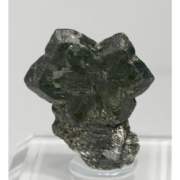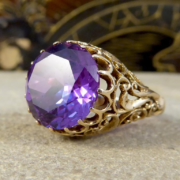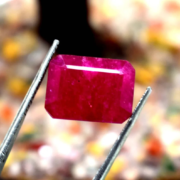Alexandrite – properties, virtues & benefits
Discover alexandrite, a rare and fascinating gemstone that changes color according to the light. This unique gem symbolizes elegance and mystery, offering an unforgettable visual experience.
ALEXANDRITE CHARACTERISTICS
- Chakra: Heart.
- Properties: Balance, harmony, transformation.
- Astrology: Mercury, JuPiter.
- Zodiac: Gemini, ScorPio.
- Elements: Air, Water.
- Colors: Green, red, purple.
- Hardness: 8.5 (Mohs scale).
- Chemical Formula: BeAl2O4 (Chrysoberyl).
- Associated god: /
ALEXANDRITE – HIS HISTORY
Alexandrite gemstone is formed from volcanic lava flows and was discovered in 1830 in the Ural Mountains of Russia. It was officially named by Finn Nordenskiöld in 1842 in honor of Tsar Alexander II. Because of its red and green color variations, the Alexandrite stone quickly became a symbol of Tsarist Russia. Russian mines were overexploited and quickly depleted, resulting in a shortage until new deposits were identified in Sri Lanka, Brazil, Tanzania, the Mozambique border and Madagascar.
.
Alexandrite is a variety of Chrysoberyl stone, with color shades ranging from a beautiful transparent yellow to a greenish-brown yellow. Its main characteristic is that it changes hue depending on the lighting, going from a vivid blue and green to a purplish red. This variation in hue has earned it the nickname “emerald by day, ruby by night”. It is considered a hard stone, with an index of 8.5 on the Mohs scale.
Alexandrite was a great success with Tiffany’s Master Gemmologist Georges Kunz, who bought large quantities of it to create numerous rings of all sizes from the late 19th to the early 20th century. It was also popular with the English in the Victorian era.
Alexandrite stone is considered to have benefits for intuition, venous and arterial circulation, imagination and creativity. It can also help combat sadness and excess by bringing more confidence and hope, as well as improving the effectiveness of treatments for long-standing physical or psychological dysfunctions. Finally, it is considered to bring good luck and love. It is one of June’s birthstones, alongside pearl and moonstone.
ALEXANDRITE STONE – ITS ORIGIN AND COMPOSITION
Alexandrite, like chrysoberyl stone and cat’s eye, is a gemstone with a particular olivine-type crystal structure, where Be2+ cations occupy the tetrahedral sites and Al3+ cations occupy the octahedral sites, with average bond lengths of Be-O = 1,638 Å and Al-O = 1,914 Å.
Alexandrite’s color varies according to the light to which it is exposed, appearing blue-green in daylight, Pink-red under artificial lighting, or transparent gray under neon. Its ability to change color is due to its strong pleochroism, which enables it to absorb several light spectrums depending on the axis with which they pass through its facets. This stone is trichroic and has three secondary shades that appear depending on the axis and origin of the illumination. It varies between green-blue, reddish and yellow tones.
The finest alexandrites came from Russian deposits, now exhausted. Stones extracted from deposits in Brazil are not of equivalent quality and do not always change color depending on the lighting. The finest stones can sell for more than some diamonds. This stone is type II, which means that it may have visible inclusions of liquid or solid matter, but this does not necessarily affect its quality. The largest stone extracted was valued at 1846 carats.
Alexandrite is slightly less hard than ruby or sapphire, but resists heat and shock well. It has a vitreous lustre and can appear transparent or translucent.

ALEXANDRITE STONE – VERTIES AND PROPERTIES
ALEXANDRITE ON THE PSYCHOLOGICAL LEVEL
Alexandrite is a rare stone that encourages the qualities of compassion and benevolence towards others. It strengthens selfless love and the ability to forgive, releasing emotional blockages and promoting greater resistance to stress. It also helps to overcome difficulties and better manage emotions, while offering a regenerative capacity and encouraging bounce-back after failure. On an esoteric level, it helps to purify the soul and achieve goals, while boosting self-confidence.
Because of its changing colors, alexandrite is associated with both love and jealousy. It is considered a symbol of stability for couples celebrating their 55th wedding anniversary. It is also considered to bring luck, prosperity and longevity in India and Sri Lanka, while mediums use it to develop their intuition. Tibetans regard Vaiduriam, a rare type of alexandrite, as a sacred stone enabling magicians to understand the language of birds and animals and bringing greater peace of mind.
.
Alexandrite encourages measure, prudence, justice, self-centeredness and self-esteem, making it indispensable for living in harmony and stepPing back to analyze problems. It can thus help promote self-questioning, problem-solving and decision-making.
ALEXANDRIA ON THE PHYSICAL LEVEL
In addition to its emotional and sPiritual properties, alexandrite also has many virtues for physical health. It promotes cardiovascular health by combating heart disorders and promoting blood flow to the brain, thereby reducing the risk of cardiovascular problems. It also helps eliminate bad cholesterol from the body and supports the emunctory functions of organs such as the pancreas, liver and spleen. It maintains the balance of the nervous and lymphatic systems, and can relieve pain in the neck and neck muscles. In addition, it soothes sore throats and reduces stress, bringing a sense of dynamism.

ALEXANDRITE STONE – CLEAN AND RECHARGE
To clean and recharge an alexandrite stone, follow these simple steps:
- Cleaning: a. Water: Place the alexandrite under a trickle of cold water for a few minutes to remove negative energies. b. Salt: Place the stone in a bowl of unrefined sea salt for a few hours or overnight.
- Recharging: a. Sunlight: Expose the alexandrite to direct sunlight for 2-3 hours to recharge it with positive energies. b. Moonlight: Place the alexandrite under the light of the full moon for an entire night for gentle, powerful recharging.
- Activation: After cleansing and recharging, hold the stone in your hands and focus on your intention. Visualize the stone’s energy connecting with yours to activate the alexandrite.
Note that gemstones can be fragile and sensitive to temperature variations and chemicals. Be sure to handle alexandrite with care when cleaning and reloading.
WHERE DOES THE NAME ALEXANDRITE COME FROM?
The name “Alexandrite” comes from the Russian tsar Alexander II (1818-1881). The gemstone was discovered in 1830 in the Urals, Russia, and was named in honor of the future tsar, who was then a grand duke. The discovery of alexandrite coincided with Alexander II’s birthday, and the stone’s changing colors – from green to red – were also the national colors of Russia at the time. These coincidences led to the gem’s association with Alexander’s name and its adoption as a symbol of Russian royalty.
WHICH CHAKRA DOES THE ALEXANDRITE ACT ON?
Alexandrite acts primarily on the heart chakra, also known as Anahata. This chakra is located in the center of the chest, near the heart, and is associated with love, compassion, emotional balance and healing. Working with the heart chakra, alexandrite can help restore emotional balance, strengthen relationships and promote inner harmony. This gemstone is also reputed to facilitate transformation and positive change in a person’s life.
WHICH ASTROLOGICAL SIGN IS ASSOCIATED WITH ALEXANDRITE?
Alexandrite is generally associated with the zodiac signs Gemini and ScorPio. Gemini is ruled by the planet Mercury, which represents communication and intellect. Alexandrite can help Geminis find balance and adapt to change. ScorPios are ruled by the planet Pluto, which symbolizes transformation and renewal. Alexandrite can support ScorPios in their quest for personal transformation and help them overcome challenges.
However, Alexandrite can also be beneficial for people born under other astrological signs, as it promotes balance, harmony and positive change in one’s life.
ALEXANDRITE STONE SUMMARY
Alexandrite is a fascinating and rare gemstone with the unique characteristic of changing color depending on the light source. It is mainly composed of chrysoberyl, a mineral that forms from beryllium aluminosilicate. Alexandrite takes its name from Tsar Alexander II of Russia, as it was first discovered in the Ural Mountains of Russia in 1830, on his birthday.
.
Color: Alexandrite is best known for its ability to change color. It generally presents an emerald green color under daylight and a raspberry-red to ruby color under artificial lighting or incandescent light.
Origin and deposits: Although originally discovered in Russia, alexandrite can also be found in Brazil, Sri Lanka, Tanzania, India, Zimbabwe and Madagascar. Russian deposits remain the most coveted, due to the exceptional quality of the stones they produce.
Value and use:Because of its rarity and unique chromatic properties, alexandrite is highly prized by collectors and gem enthusiasts. It is also used in jewelry, notably for rings, necklaces and earrings. Large stones with pronounced color changes are particularly sought-after, and can fetch very high prices on the market.
Symbolism and virtues: alexandrite is considered a stone of good fortune, transformation and sPiritual growth. It is also associated with balance, self-confidence and creativity. In some traditions, it is thought to enhance intuition and promote harmony in relationships.
Care: Alexandrite is a relatively hard stone, with a hardness of 8.5 on the Mohs scale, making it resistant to scratches. To clean it, use lukewarm water, mild soap and a soft-bristled brush. Ultrasonic cleaners and sudden temperature changes should be avoided to preserve the beauty of the stone.





